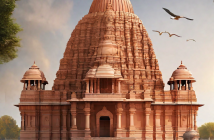Discover the spiritual awakening with ‘Divine Dawn: Ayodhya Ram Mandir Pran Pratishtha‘. Explore how this historic event symbolizes unity and faith, merging art, architecture, and spirituality. A new beginning beckons.
Introduction: A New Era of Faith and Unity
The Pran Pratishtha ceremony at Ayodhya Ram Mandir marks a transformative epoch in India’s cultural and spiritual landscape. This auspicious event, signifying the consecration of the deity Lord Ram, heralds a ‘Divine Dawn’, awakening faith and communal harmony. This article delves into the profound significance of this ceremony, exploring its historical roots, contemporary relevance, and the intricate fusion of faith, art, and architecture that this monumental event embodies.
Historical Context: A Legacy Reborn
The Saga of Ayodhya and Ram
Ayodhya, a city steeped in legend and lore, is believed to be the birthplace of Lord Ram, a central figure in Hindu mythology. The narrative of Ramayana, an epic that transcends time, has imbued Ayodhya with a unique spiritual significance.
Evolution of the Ram Mandir
The history of the Ram Mandir is a tapestry of faith and resilience. The recent reconstruction of the temple, after prolonged legal and social debates, signifies not just the restoration of a structure but the revival of a legacy.
Pran Pratishtha Ceremony: An Auspicious Beginning
The Rituals and Their Symbolism
Pran Pratishtha is a Vedic ritual where the deity is invoked to reside in the idol, infusing it with divine energy. This ceremony, involving elaborate rituals and chanting of sacred hymns, transcends mere religious formalities, symbolizing the awakening of divine presence.
Impact on Devotees and Community
This event has been a religious milestone and a catalyst for communal harmony and spiritual rejuvenation. For devotees, it’s a moment of profound spiritual fulfilment, witnessing the dawn of a new spiritual era.
Contemporary Relevance: More Than a Temple
A Symbol of Cultural Unity
In a nation as diverse as India, the Ayodhya Ram Mandir stands as a beacon of cultural unity. It transcends religious boundaries, inviting people from various backgrounds to partake in a shared heritage.
The Mandir’s Role in Modern Society
In an age of rapid modernization, the Ram Mandir reminds us of the enduring relevance of faith and tradition. It’s a testament to the coexistence of ancient beliefs and contemporary values.
Fusion of Faith, Art, and Architecture
Architectural Splendor
The temple’s architecture is a marvel, blending traditional Vastu Shastra principles with modern aesthetics. It’s not just a place of worship but a symbol of ancient India’s artistic and architectural prowess, resurrected in modern times.
Artistic Expressions
The temple’s walls and halls narrate stories from the Ramayana, etched and painted by skilled artisans. This amalgamation of art and spirituality makes the temple a living museum of cultural heritage.
Real-life Examples and Statistics
Impact on Ayodhya and Beyond
The temple’s construction has revitalized Ayodhya, with increased tourism and economic growth. Statistics show a significant rise in pilgrims and tourists, contributing to the local economy and national pride.
Global Influence
The temple has garnered international attention, symbolizing India’s rich cultural tapestry and its ability to blend tradition with modernity.
Conclusion: A Beacon of Hope and Harmony
The Pran Pratishtha ceremony at Ayodhya Ram Mandir is not just a religious event; it’s a celebration of unity, faith, and cultural resurgence. It symbolizes a Divine Dawn, a new beginning for a community bonded by shared beliefs and hopes. In its majestic glory, the temple stands as a testament to the enduring power of faith and the unifying strength of shared heritage. As we look towards the future, the Ayodhya Ram Mandir remains a beacon of hope, guiding the way towards a more harmonious and spiritually enriched world.




